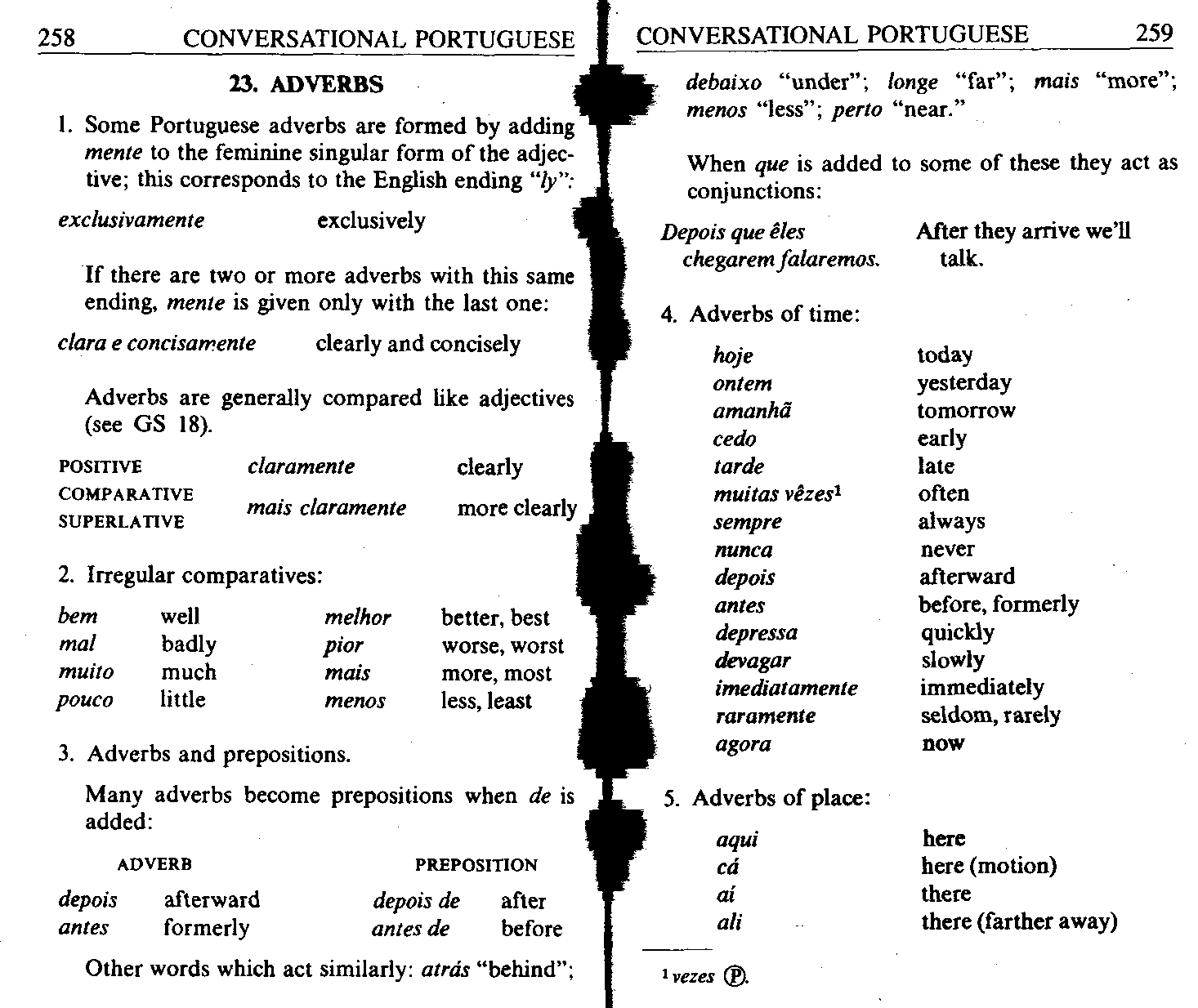Summary p258

258 CONYERSATIONAL PORTUGUESE
23. ADYERBS
1. Some Portuguese adverbs are formed by adding menie to the feminine singular form of the adjec-tive; this corresponds to the English ending “ty”:
exclusively
exclusivamente
If there are two or morę adverbs with this same ending, menie is given only with the last one:
clara e concisamente clearly and concisely
Adverbs are generally compared like adjectives (see GS 18).
POSITIVE COMP A RATIVE SUPERLATIYE
claramente mais claramente
clearly morę clearly
2. Irregular comparatives:
|
bem |
well |
melhor |
better, best |
|
mai |
badly |
piór |
worse, worst |
|
muito |
much |
mais |
morę, most |
|
pouco |
little |
menos |
less, least |
3. Adverbs and prepositions.
Many adverbs become prepositions when de is added:
adverb
depois afterward
PREPOSITION
depois de antes de
after
before
antes formerly
Other words which act similarly: atrds “behind”;
debaixo “under”; longe “far”; mais “morę”; menos “less”; perto “near.”
When que is added to some of these they act as conjunctions:
|
Depois que ileś |
Afiter they arrive we’] |
|
chegarem falaremos. |
talk. |
|
4. Adverbs of time: | |
|
hoje |
today |
|
ontem |
yesterday |
|
amanhd |
tomorrow |
|
cedo |
early |
|
tarde |
late |
|
muitas vizes1 |
often |
|
sempre |
always |
|
nunca |
never |
|
depois |
afterward |
|
antes |
before, fonnerly |
|
depressa |
quicldy |
|
deyagar |
slowly |
|
imediatamente |
immediately |
|
raramente |
seldom, rarely |
|
agora |
now |
|
5. Adverbs of place: | |
|
aqui |
here |
|
ca |
here (motion) |
|
ai |
there |
|
ali |
there (farther away) |
1 \ezes (P).
Wyszukiwarka
Podobne podstrony:
70017 img021 (23) TeaifiworkVocabufary Many nouns can be formed by adding suffixes (e.g. -ation an
Summary p256 256 CONYERSATIONAL PORTUGUESE 21. SOME CONJUNCTIONS ainda que assim que ate
Summary p302 302 CONYERSATIONAL PORTUGUESE 42. SPELLING CHANGES IN YERBS Some verb forms, as is tr
Summary p304 304 CONYERSATIONAL PORTUGUESE Some of the other verbs in -gar: apagar to put out, e
Summary p222 222 CONYERSATIONAL PORTUGUESE 21. Vamos_(to have dinner). a. jantar
Summary p224 224 CONYERSATIONAL PORTUGUESE (3) variations occur in different areas: a.
Summary p226 226 CONYERSATIONAL PORTUGUESH CONYERSATIONAL PORTUGUESE 227 d g g h j I I Ut m as d i
Summary p230 230 CONYERSATIONAL PORTUGUESE 3, The cedilla (cedilha) is used with
Summary p234 234 CONYERSATIONAL PORTUGUESE k. with parts of the body and articles of clothing inst
Summary p236 236 CONYERSATIONAL PORTUGUESE De and em combine with the demonstrative forms (see GS2
Summary p238 238 CONYERSATIONAL PORTUGUESE 13. MASCULINE AND FEMININE 238 CONYERSATIONAL PORTUGUES
Summary p240 240 CONYERSATIONAL PORTUGUESE 14. THE PLURAL 1. Nouns ending in a vowel, including na
Summary p242 242 CONYERSATIONAL PORTUGUESE seu can also be used to translate “his,” “her,” “their.
Summary p246 246 CONYERSATIONAL PORTUGUESE 1«. COMPAR1SON 1. Rcgular comparison facil easy ma
Summary p248 248 CONYERSATIONAL PORTUGUESE 19. PRONOUNS Pronouns have varying forms depending on w
Summary p250 250 CONYERSATIONAL PORTUGUESE CONYERSATIONAL PORTUGUESE_ 251 (te) I
więcej podobnych podstron